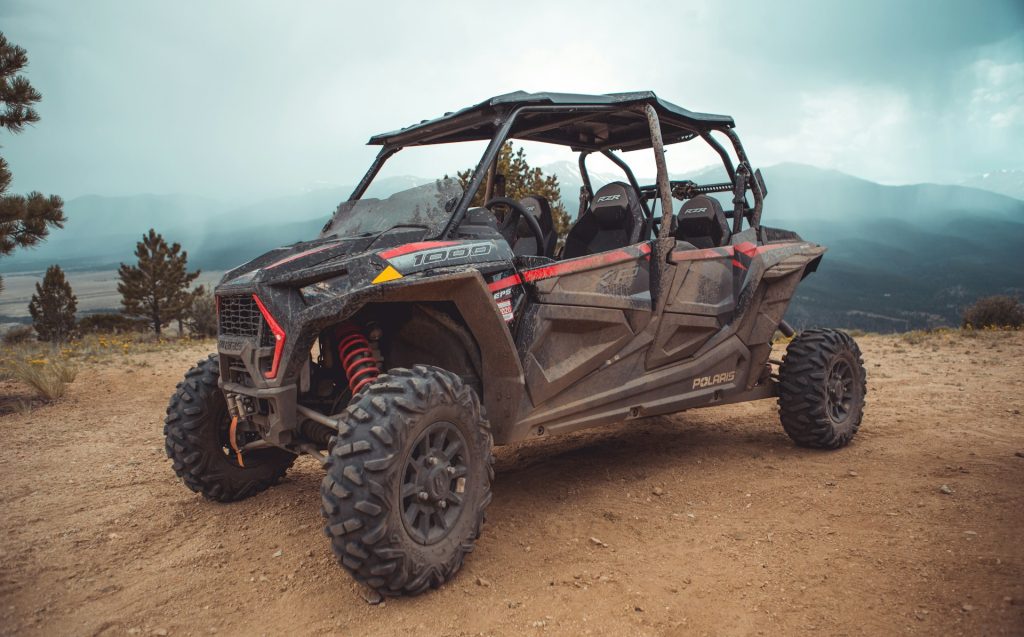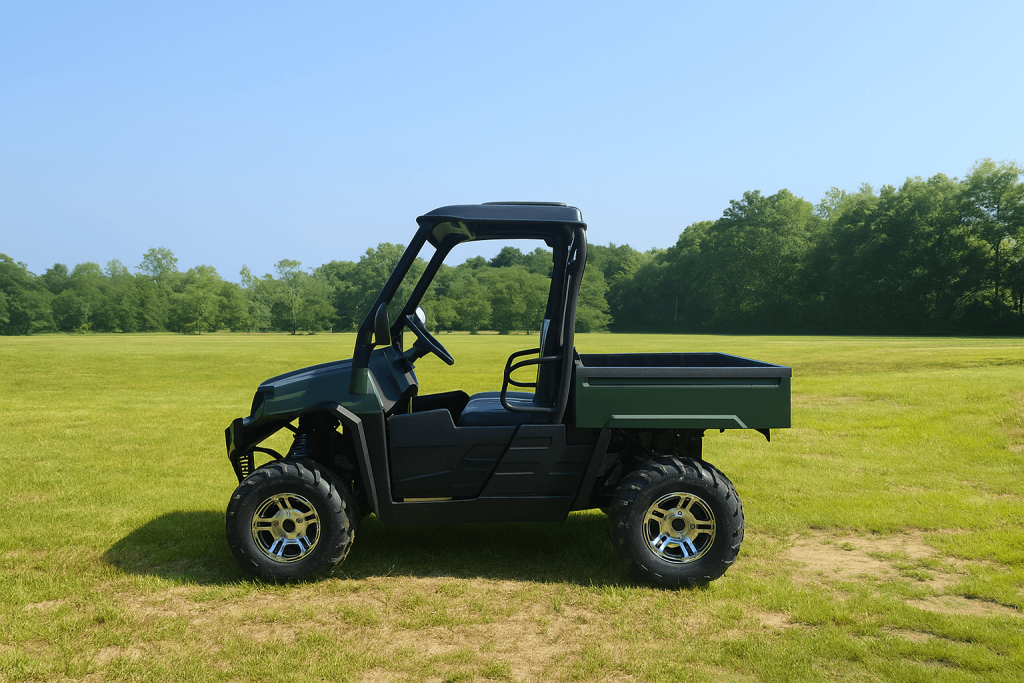Choosing between a UTV and an ATV comes down to how you ride and what you need. If you’re mostly riding solo through tight trails and want something light and nimble, an ATV is probably your best bet. But if you’re planning to carry gear, bring a passenger, or need something more stable for work or family trips, a UTV might make more sense. This guide breaks down the key differences to help you decide with confidence.
What’s the Main Difference Between a UTV and an ATV?
The design and passenger capacity determine the fundamental difference. An ATV features a straddle seating position with handlebars. It accommodates one passenger. A UTV provides side-by-side seating. It has a steering wheel and bucket seats for multiple passengers. These utility task vehicles include safety features – seat belts and a roll cage. When purchasing used models, use a VIN decoder to verify specifications.
| Feature | ATV | UTV |
| Seating | Straddle position, one passenger | Side by side, 2-6 passengers |
| Control | Handlebars | Steering wheel |
| Safety | Basic protection | Cage, seat belts |
| Cargo | Limited storage space | Substantial cargo capacity |
| Terrain Access | Narrow trails, tight spaces | Wider paths, open terrain |
Technical Features Breakdown: How UTVs and ATVs Compare

Both vehicle types offer distinct technical advantages suited for different purposes. Both vehicle types offer distinct technical advantages suited for different purposes. For example, some riders prioritize responsive handling and a lightweight build to tackle narrow trails or quickly shift direction on uneven ground. Others need consistent traction on loose surfaces, smooth power delivery while hauling heavy loads, or enhanced control during steep descents. These differences aren’t just about engine size.
Both vehicle types offer distinct technical advantages suited for different purposes. “ATV buyers usually want speed and agility,” says an expert at A Better Bid, “while UTV shoppers look for stability and hauling power.”
Drivetrain, Transmission & Power Delivery
Modern off-road drivetrains vary between these vehicle types. Each ATV typically features simpler transmission systems, while each UTV includes sophisticated CVT transmissions. Both utilize four wheels with 2WD/4WD systems.
| Component | ATV | UTV |
| Transmission | Manual/Automatic/CVT | Primarily CVT |
| Drive System | Selectable 2WD/4WD | Selectable 2WD/4WD |
| Power Delivery | Direct, responsive | Smooth, controlled |
| Differential | Limited slip available | Electronic locking common |
Engine Types & Horsepower Range
These utility terrain vehicles offer different engine configurations. Each all-terrain vehicle focuses on lightweight performance. UTVs prioritize torque and hauling capability. The horsepower range also varies.
ATV Engine Options:
- Single-cylinder engines: 90-400cc, 8-35 HP.
- Twin-cylinder engines: 400-1000cc, 35-90 HP.
- Sport models: High-revving, performance-oriented, equipped with advanced suspension.
- Utility models: Torque-focused for farm work, suitable for hauling with rear storage space.
UTV Engine Options:
- Single-cylinder utility: 400-500cc, 32-40 HP, foot pedals for control.
- Twin-cylinder recreational: 500-850cc, 50-75 HP, easier to maneuver.
- High-performance: 900-1000cc, 100+ HP, suitable for tight turns.
- Turbocharged variants: Enhanced power with rear-mounted cooling systems.
Fuel Capacity
Fuel capacity directly impacts your off-road adventures. ATVs typically feature smaller fuel tanks. They range from 2.5 to 5.5 gallons. These volumes reflect their lighter weight and fuel efficiency.
UTVs accommodate larger fuel tanks. They’re usually between 7 and 12 gallons. Such tanks support increased power demands and longer expedition capabilities. This capacity is vital when transporting equipment or passengers across rugged terrain.
According to A Better Bid, the average ATV achieves 15-25 miles per gallon. UTVs typically deliver 8-15 MPG. It’s due to their larger engines and increased weight.
Pros and Cons of ATV vs UTV
Grasping the advantages and limitations helps plan the best purchase. Each ATV excels in maneuverability and hunting applications. Each UTV offers comfort and the opportunity to carry equipment for recreation activities.
| Aspect | ATV Pros | ATV Cons | UTV Pros | UTV Cons |
| Cost | Lower purchase price | Limited passenger capacity | Higher resale value | Higher initial investment |
| Maneuverability | Navigate narrow trails easily | Less stable on steep inclines | Excellent stability | Cannot access tight spaces |
| Safety | Lighter, less rollover risk | No roll cage protection | Comprehensive safety features | Heavier, requires more skill |
| Versatility | Quick, agile performance | Limited ability to carry cargo | Exceptional storage, can carry multiple items | Wider turning radius |
Popular Brands and Top Models of Utility Vehicles

The market features established UTV vehicle brands producing these types of utility vehicles. They’ve developed reputations for reliability and innovation. Nonetheless, research is essential. Budget-conscious buyers may explore salvage ATVs with careful inspection.
Leading Off-Road Vehicle Manufacturers:
- Honda: Pioneer series UTVs, FourTrax ATV lineup for hunting.
- Polaris: RZR sport UTVs, Sportsman utility ATVs that carry gear well.
- Can-Am: Maverick recreational UTVs, Outlander ATVs for hunting enthusiasts.
- Yamaha: Wolverine utility UTVs, Grizzly ATVs.
- Kawasaki: Mule utility UTVs, Brute Force ATVs.
- John Deere: Gator utility vehicles for farm work.
- CFMOTO: Budget-friendly options with solid warranties.
Safety Comparison: Which Vehicle Is Safer?
Each UTV provides superior protection through engineered safety features. Each ATV relies on rider skill and gear.
| Safety Feature | ATV | UTV |
| Roll Protection | None (requires helmet) | Built-in roll cage |
| Restraint System | No belts | Factory belts |
| Passenger Protection | Single rider only | Multiple passengers secured |
| Stability | Higher center of gravity | Lower, wider stance |
| Visibility | 360-degree view | Improved forward visibility |
UTVs have 40% fewer injury incidents per mile compared to ATVs. It’s primarily due to their enhanced safety features and structural protection.
Which Vehicle Holds Its Worth?
UTVs typically maintain better resale value than ATVs. It’s due to their versatility and family appeal. The ability to haul equipment and carry multiple passengers makes UTVs attractive to numerous riders. However, well-maintained ATVs also retain decent value. This particularly concerns high-performance vehicles. Understanding the best ways to buy a used car applies equally to off-road vehicle purchases.
Trail Access Rules & Legal Restrictions
Understanding access regulations is essential for riders. Different jurisdictions impose varying restrictions based on vehicle width and safety. Each UTV faces more limitations due to its larger size, while each ATV enjoys broader access.
ATV Trail Access:
- Most public trail systems accommodate standard four-wheeler dimensions.
- Generally allowed on narrow and single-track paths.
- Fewer restrictions in national forests and state parks.
- Often permitted on designated roads and right-of-ways.
UTV Trail Access:
- Limited to wider trails due to larger size constraints.
- Prohibited on many single-track and narrow systems.
- Increasing acceptance of designated UTV trail networks.
- May require special permits or registration in some areas.
35% of public trail systems restrict UTV access due to width limitations, while only 8% restrict properly registered ATVs.
Environmental Impact & Electric Alternatives

Both ATVs and UTVs impact the environment. It’s through the noise, emissions, and terrain disturbance. Electric alternatives are viable options for environmentally conscious riders. These vehicles offer quieter operation and zero emissions. They, however, maintain performance capabilities. When shopping for used options, avoid any flood-damaged car listings. Water exposure severely compromises electrical systems.
Electric models currently represent about 3% of the off-road car market. However, they’re growing rapidly. Battery technology improves. Charging infrastructure, in turn, expands nationwide.
Transporting Your Off-Road Vehicle
Transportation requires careful planning and appropriate equipment. Each ATV is easier to transport. It’s due to its smaller size. Each UTV demands larger trailers. When evaluating pre-owned vehicles, research the average number of owners by car type. Multiple owners may indicate reliability concerns.
- ATV Transport: A Standard pickup truck bed or a small trailer is sufficient.
- UTV Transport: Requires a larger trailer and a capable tow vehicle.
- Trailer Types: Open utility, enclosed cargo, or tilt-bed options.
- Loading Equipment: Ramps, winches, and tie-down systems are essential.
- Legal Compliance: Proper lighting, licensing, and weight distribution.
Summary
The choice between ATV vs UTV depends on your specific needs. Consider the intended use. ATVs excel for solo riders who prioritize maneuverability on narrow trails. UTVs serve families and work applications requiring passenger capacity and cargo hauling. Both car types offer distinct advantages for different off-road adventures and tasks.
![]() FAQ
FAQ
Show more
Can ATVs Drive on Ice?
Yes. ATVs can operate on ice with proper tires. However, cautious riding techniques are essential. Ice-specific tires provide better traction and control.
What Is the Most Expensive UTV Brand?
Can-Am, Polaris RZR Pro models, and specialty racing brands produce the most expensive vehicles. Their prices exceed $30,000 for top-tier performance models.
What State Has the Most ATV Accidents?
West Virginia consistently reports the highest ATV accident rates. It’s followed by Alaska and Montana. Challenging terrain and remote riding conditions define these statistics.
How Does Riding an ATV or UTV Compare to a Motorcycle?
Compared to motorcycles, both ATVs and UTVs offer different experiences:
– Stability: Four wheels provide better stability.
– Learning Curve: Generally easier for beginners.
– Terrain Capability: Superior performance on challenging surfaces.
– Speed Limits: Typically slower maximum speeds.
– Protective Gear: UTVs offer built-in protection; ATVs require similar gear to motorcycles.
Are There Any Tax Deductions for Buying a UTV for Business?
Yes. UTVs purchased for legitimate business purposes may qualify for tax deductions. These include Section 179 depreciation allowances for equipment used in farming, construction, or other commercial applications.

:format(webp)/vulcan.abetter.bid%2Fwp-content%2Fuploads%2F2025%2F09%2Fvasile-valcan-1HqixV1agUw-unsplash.jpg)
:format(webp)/vulcan.abetter.bid%2Fwp-content%2Fuploads%2F2022%2F10%2F2022-10-05-11.30.40-150x150.jpg)
 FAQ
FAQ :format(webp)/vulcan.abetter.bid%2Fwp-content%2Fuploads%2F2025%2F07%2Fwalter-sturn-Rd8FuyvGRGY-unsplash.jpg)
:format(webp)/vulcan.abetter.bid%2Fwp-content%2Fuploads%2F2025%2F02%2Fscott-rodgerson-ffH_GkINfyY-unsplash.jpg)
:format(webp)/vulcan.abetter.bid%2Fwp-content%2Fuploads%2F2025%2F07%2Fmarc-serota-f3Vz3tw6kVY-unsplash.jpg)
:format(webp)/vulcan.abetter.bid%2Fwp-content%2Fuploads%2F2025%2F10%2Fcopart-vs-a-better-bid.png)
:format(webp)/vulcan.abetter.bid%2Fwp-content%2Fuploads%2F2025%2F10%2Fcopart-vs-iaai-1.png)
:format(webp)/vulcan.abetter.bid%2Fwp-content%2Fuploads%2F2025%2F09%2Fvasile-valcan-1HqixV1agUw-unsplash.jpg)

